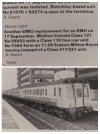As I understand it, the Albion engines were just 8-cylinder 230hp versions of the common 6-cylinder Leyland 150hp engines. Leyland had owned Albion since about 1950, and used the brand for their more heavyweight commercial vehicles, mostly for export.
Likewise the Rolls-Royce higher powered engines (actually designed and built by Sentinel in Shrewsbury) were 8-cylinder 238hp versions of the 6-cylinder 180hp units used in some North Eastern Region cars.
BUT (British United Traction) appears to have been just a joint sales and marketing front organisation for Leyland and AEC, who in most other respects such as building of buses were direct competitors of one another at the time. The engines don't seem to have been interchangeable at all, in their road vehicles for example the exhausts were on opposite sides of the block, and presumably all the spares etc were quite different.
Of the three principal manufacturers of diesel engines of this type and size in road vehicles in the era (far and away the main market), Leyland, AEC and Gardner, notable that the railcars only used the first two, and excluded Gardner, whereas for the small BR diesel shunters built at the same time Gardner powered them all and the railcar engine builders were not used.



